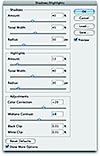- Approaching Color Correction
- Levels
- Curves
- Hue/Saturation
- Color Balance
- Useful Image Adjustments
Useful Image Adjustments
While a Levels or Curves command usually can get the color correction job done, atypical problems often require particular commands. These other commands have special purposes and should generally be reserved for the unique problems they address. Let's take a look at the specialty commands.
Black & White
If you want to create a dramatic grayscale or duotone effect, the most effective way is to use a Black & White adjustment layer. But unlike a simple saturation adjustment, with this option you maintain full control over how individual colors are converted. This approach allows you to emphasize or deemphasize specific colors and tonal ranges. Additionally, you can tint the grayscale by applying a color tone to the image (such as a sepia tone).
- Close any open files, and then open the file Ch10_Black White Conversion.tif from the Chapter 10 folder (see Figure 42).
- Click the Black & White icon in the Adjustments panel (see Figure 43).
- Photoshop performs a default grayscale conversion. You'll want to adjust the conversion using the color sliders. You can also apply an Auto conversion or use a saved custom mix.
You can adjust the color sliders to emphasize gray tones of specific colors in an image. Each image is unique, so you'll need to find the right balance. Drag a slider to the left to darken or to the right to lighten. Be sure to select the Preview checkbox so you can see the results of your changes.
- With the Black & White command window open, click the icon in the Adjustments panel that looks like a pointing finger (see Figure 44).
- You can click somewhere on the image to sample a target. The mouse pointer changes to an eyedropper if you move it over the image. Just click and hold on an image area to target the right color slider for the strongest color at that location. Then drag to shift the color slider for that color, thus making it lighter or darker (see Figure 45).
- To create a duotone effect, select the Tint option. To change the tint color, click its swatch and use the Color Picker to choose a new color that matches your needs.
Photo Filter
Professional photographers often place glass filters in front of the camera lens. These filters can be used to "cool" or "warm" a picture, or to add special effects. Since Photoshop often tries to simulate or correct for steps not taken in the field, the addition of Photo Filters was a logical evolution for Photoshop.
Adobe added to the "real-time" color correction options with the addition of 20 different adjustments. These layers simulate the traditional colored glass filters. In addition to the built-in presets, you can choose custom colors from the Photo Filter interface using the standard Color Picker.
There are three main groupings for color effects:
- Warming Filter (85 and LBA) and Cooling Filter (80 and LBB). These adjustment layers are meant to even out photos that were not properly white-balanced. The Cooling Filter (80 or LBB) makes images bluer to simulate cooler ambient light. The Warming Filter (85 or LBA) makes images warmer to simulate hotter ambient light.
- Warming Filter (81) and Cooling Filter (82). These adjustment layers are similar to the previous filters but cast a more pronounced color. The Warming Filter (81) makes the photo more yellow, and the Cooling Filter (82) makes the photo bluer.
- Individual colors. The Photo Filter also has 14 preset colors to choose from. These can be used for two primary purposes: to add a complementary color to a scene to remove color cast, or for stylistic reasons.
Let's try applying a Photo Filter adjustment layer.
- Close any open files, and then open the file Ch10_Photo_Filter.tif from the Chapter 10 folder (see Figure 46).
- Click the Photo Filter icon in the Adjustments panel (see Figure 47).
- In the Filter area, choose Cooling Filter (80) to adjust the temperature of the photo. The sky and the image now should be "bluer" (see Figure 48). You can adjust the Density slider to control the intensity of the effect.
Shadows/Highlights
Exposure problems often plague photos. Dark shadows may make a photo seem unusable, but Photoshop offers a powerful and flexible image command for fixing these problems. The Shadows/Highlights command can help salvage images in which the subject is silhouetted from strong backlight. You can also use the command to improve subjects that have been washed out by the camera's flash.
The Shadows/Highlights command does more than just lighten or darken an image. It makes adjustments by analyzing neighboring pixels. However, when first opened, the tool is very basic. It's important to select the Show More Options checkbox, which adds significant control. Let's give the command a try.
- Close any open files, and then open the file Ch10_Shadows_Highlight_1.tif from the Chapter 10 folder (see Figure 49).
The Shadow/Highlights command is not available as an adjustment layer. You can still apply it in a nondestructive manner, however, by first converting the photo to a smart object.
Choose Layer > Smart Objects > Convert to Smart Object.
- Choose Image > Adjustments > Shadows/Highlights. The image is brightened automatically because the command boosts the shadowed areas by default.
- Select the Show More Options checkbox and the Preview checkbox (see Figure 50).
- Adjust the Shadows and Highlights of the image as needed:
- Amount: Value determines the strength of adjustment made to the image.
- Tonal Width: Small values affect a reduced region; larger values include the midtones. If pushed too high, halos appear around the edges of the image.
- Radius: A tolerance setting that examines neighboring pixels to determine the affected area.
- Modify the image adjustments to improve image quality (see Figure 51):
- Color Correction: This slider modifies the saturation of the adjusted areas. Essentially, it can counterbalance washed-out images.
- Brightness: If you're working on a grayscale image, Color Correction is replaced by a Brightness control.
- Midtone Contrast: This adjustment affects the contrast in the midtones of a photo. Positive values increase contrast; negative values reduce contrast.
- Black Clip, White Clip: These adjustments modify the black point of shadows and lower the white point of highlights. This change can lower the intensity of the effect.
- Click Save if you'd like to store the adjustment to use on another photo. When you're satisfied, click OK to apply the adjustment.
- If you'd like extra practice, open the image Ch10_Shadows_Highlights_2.tif and repeat the command.
Exposure for Raw Files
The Exposure command is also an important part of processing a raw file using Camera Raw. Even though a photo may appear overexposed, often you can expose it properly during the development stage.
- Close any open files, and then open the file Ch10_Recover_Raw.NEF from the Chapter 10 folder (see Figure 52).
- Adjust the Exposure and Recovery sliders until the image is exposed more properly.
- Further refine the image using the additional sliders on the Basic tab. Be sure to adjust the Fill Light, Blacks, Contrast, and Clarity sliders to get the best image (see Figure 53).
The flexibility offered by the various raw formats and the Camera Raw developing module are excellent reasons for upgrading your digital photography acquisition approach.











